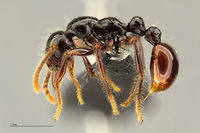Aretidris clousei
| Aretidris clousei | |
|---|---|

| |
| Scientific classification | |
| Kingdom: | Animalia |
| Phylum: | Arthropoda |
| Class: | Insecta |
| Order: | Hymenoptera |
| Family: | Formicidae |
| Subfamily: | Myrmicinae |
| Tribe: | Crematogastrini |
| Genus: | Aretidris |
| Species: | A. clousei |
| Binomial name | |
| Aretidris clousei General, 2015 | |
This species was collected by leaf litter sifting. It forages diurnally as individuals in the leaf litter.
Identification
- Head and mesosoma heavily sculptured; erect hairs moderately abundant on head and mesosoma; 1st gastral tergite slightly less than half the length of gaster; body larger (HW > 0.88) . . . . . Aretidris buenaventei
- Head and mesosoma mostly smooth; erect hairs sparsely distributed on head and mesosoma; 1st gastral tergite extremely large, accounting for most of the length of gaster; body smaller (HW < 0.84) . . . . . Aretidris clousei
Distribution
Distribution based on Regional Taxon Lists
Indo-Australian Region: Philippines (type locality).
Distribution based on AntMaps
Distribution based on AntWeb specimens
Check data from AntWeb
Countries Occupied
| Number of countries occupied by this species based on AntWiki Regional Taxon Lists. In general, fewer countries occupied indicates a narrower range, while more countries indicates a more widespread species. |

|
Estimated Abundance
| Relative abundance based on number of AntMaps records per species (this species within the purple bar). Fewer records (to the left) indicates a less abundant/encountered species while more records (to the right) indicates more abundant/encountered species. |

|
Biology
This is likely the same species that was included in the phylogenetic analysis of Lordomyrma (Lucky & Sarnat 2010) as 'Genus undet. PH03'. Although the outgroup sampling was very limited, the analysis suggested the genus is a close relative of Lordomyrma.
Castes
Known only from the worker caste.
Nomenclature
The following information is derived from Barry Bolton's Online Catalogue of the Ants of the World.
- clousei. Aretidris clousei General, 2015: 134, figs. 7-12 (w.) PHILIPPINES (Luzon).
- Type-material: holotype worker, 4 paratype workers.
- Type-locality: holotype Philippines: Luzon I., Sorsogon Prov., Bulusan Municipality, Bulusan Volcano Natural Park, Aguingay Lake, Southwest Ridge, 900 m., 12°46’13’’N, 124°4’16’’E, 9.vi.2014, (PNM 9004) (R. Clouse); paratypes: 2 workers with same data, 2 workers with same data but 10.vi.2014.
- Type-depositories: NMPM (holotype); ANIC, BMNH, MCZC, UPLB (paratypes).
- Distribution: Philippines (Luzon).
Unless otherwise noted the text for the remainder of this section is reported from the publication that includes the original description.
Description
Worker
Holotype. CI 87, EI 23, EL 0.19, HFL 1.13, HL 0.95, HW 0.83, ML 1.38, MtL 1.23, PW 0.68, SI 103, SL 0.85, TL 4.65. Paratypes: CI 84 - 89, EI 20 - 24, EL 0.16 - 0.20, HFL 1.10 - 1.15, HL 0.93 - 0.98, HW 0.80 - 0.84, ML 1.33 - 1.40, MtL 1.13 - 1.23, PW 0.68 - 0.73, SI 97 - 106, SL 0.80 - 0.88, TL 4.55 - 4.76 (4 measured). With all the character states of the genus. Body mostly smooth. Scattered punctures over the head and mesosoma bear long erect to suberect hairs. First gastral tergite (= abdominal tergite IV) huge, accounting for most of the length of gaster.
Type Material
Holotype worker, Philippines: Luzon Island, Sorsogon Province, Municipality of Bulusan, Bulusan Volcano Natural Park, Aguingay Lake, Southwest Ridge, 900 m a.s.l., 12° 46' 13" N 124° 04' 16" E, 9.VI.2014, secondary forest, ex leaf litter, leg. R. Clouse (National Museum of the Philippines 9004) (deposited in PNM). Paratypes: 2 workers with same data as holotype; 2 workers with same data as holotype except 10.VI.2014 (PNM 9005 - 9008) (one pin each to: Australian National Insect Collection, The Natural History Museum, Museum of Comparative Zoology, University of the Philippines Los Baños).
Etymology
This species is dedicated to my good friend Ronald M. Clouse who collected all the type specimens.
References
- General, D.E.M. 2015. Aretidris, a new genus of ants (Hymenoptera: Formicidae: Myrmicinae) from the mountains of Luzon Island, Philippines. Myrmecological News, 21, 131-136.
- Lucky, A. and Sarnat, E. M. (2010), Biogeography and diversification of the Pacific ant genus Lordomyrma Emery. Journal of Biogeography, 37: 624–634. doi:10.1111/j.1365-2699.2009.02242.x | PDF

